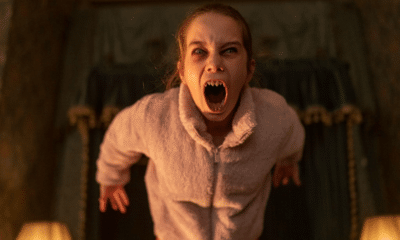When asked to think of European horror films, the mind tends to instantly turn to those made in France, Spain or Germany. A country that doesn’t spring to mind is Hungary, and that’s because they don’t really have any horror content, with Péter Bergendy’s Post Mortem being one of its first. Set in 1918 during the Spanish flu, Post Mortem joins Tomas (Viktor Klem), a post mortem photographer, and a young girl called Anna (Fruzsina Hais) as they confront ghosts in a post World War I haunted village.

We first meet Tomas on the battlefield, a place where he dies, at least temporarily. After leaving the army he continues his photography career, but he is running out of subjects. Then he meets Anna who tells him of all those that fell ill and died in her village. Tomas, seeing the opportunity for a stable income, accepts Anna’s invitation and begins photographing all the dead. The dead however, are not happy, and with Tomas having had one foot in each realm, they begin trying to reach out to him.
Post Mortem spends a lot of time with and around the dead. The first third of the movie is spent watching Tomas at work and the sequences that see Tomas taking images of the deceased are played in near silence, the eeriness palpable. Tomas himself is untouched by the sense of dread, but it envelops loved ones as they enter for their final portrait together. Given the nature of the genre, any expectations of moving bodies will push the viewer down the wrong path. These corpses do not attack, but something connected to them begins to appear on the developing photographs and the narrative undertakes a mysterious shift.
Despite its serious sombre tone, Post Mortem retains a strong sense of fun, the ghost work presenting one of the most entertaining interpretations of spirits on screen. As our dead get progressively more distressed by Tomas and Anna’s inability to understand what they are trying to communicate, they turn on them and the villagers. The villagers are literally thrust around rooms, dragged down streets and basically treated like living rag dolls. It’s a strange tonal switch, from stark and serious to arguably silly, but regardless of how jarring this may be, it makes for some very enjoyable sequences.
The problem with Post Mortem is that, although there is an atmosphere that is generated, it’s never hugely atmospheric. There might be moody visuals and tone, but this doesn’t quite follow through into the feel of the piece. This is potentially down to a combination of the day time settings and the simple fact that Tomas seems rather nonplussed about what is unfolding. Given his work with the dead, he would obviously be comfortable around them, but with no lead characters reacting scared, it’s hard to then inject that atmosphere into the piece. The run time also causes some issues, the pace is slow and dreary in places, and one can’t help but think that the story would flow better with twenty minutes or so sawn off.
Nonetheless, Bergendy has achieved some great feats within Post Mortem. Firstly, it looks expensive. Making any film is costly, but making a wartime period ghost story adds extra pressure to the budget and Bergendy and his team have done exceptional work to create a whole expansive village. Post Mortem opens in the heat of battle, Bergendy not shying away from his limitations whatsoever. The director’s interpretation of ghosts will have also caused a drain on resources, but everything that has been put in the film is entirely worth it.
A great early venture in horror for a country with a distinct lack of genre films, Post Mortem rises above its modest budget, looking super expensive. It also manages to be the most inventive version of spooks on screen in years, providing an unexpected amount of fun for the piece. A few tweaks in terms of run time and scare factor, and we’d have something extra special.
Post Mortem
Kat Hughes
Summary
For an early dabble into genre cinema, Post Mortem’s war time ghost story has a surprising amount of fun to it, it’s just lacking the more conventional scare factor.
Post Mortem was reviewed at Arrow Video FrightFest 2021. Post Mortem is sold internationally by NFI World Sales.
Kat Hughes is a UK born film critic and interviewer who has a passion for horror films. An editor for THN, Kat is also a Rotten Tomatoes Approved Critic. She has bylines with Ghouls Magazine, Arrow Video, Film Stories, Certified Forgotten and FILMHOUNDS and has had essays published in home entertainment releases by Vinegar Syndrome and Second Sight. When not writing about horror, Kat hosts micro podcast Movies with Mummy along with her five-year-old daughter.

Latest Posts
-


Film Trailers
/ 22 hours agoM. Night Shyamalan’s ‘Trap’ trailer lands
Anew experience in the world of M. Night Shyamalan.
By Paul Heath -


Film News
/ 2 days agoFirst ‘Transformers One’ teaser trailer debuts IN SPACE!
The animated feature film is heading to cinemas this September.
By Paul Heath -


Film Reviews
/ 2 days ago‘Abigail’ review: Dirs. Matt Bettinelli-Olpin & Tyler Gillett (2024)
Matt Bettinelli-Olpin and Tyler Gillett direct this new horror/ heist hybrid.
By Awais Irfan -


Film Trailers
/ 2 days agoNew trailer for J.K. Simmons-led ‘You Can’t Run Forever’
A trailer has dropped for You Can’t Run Forever, a new thriller led by...
By Paul Heath















